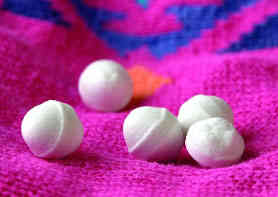Mothballs (Naphthalene) Do Not Repel Termites
Formosan termites may not worry about moth holes in their sweaters, but they are the first insects discovered to fumigate their nests with naphthalene. Scientists have discovered that termites, like the Formosan Subterranean Termite (Coptotermes formosanus), produce naphthalene - a hydrocarbon - which they apparently use as a defense against natural enemies, such as ants.
A termite nest is a closed system which protects the termites in a microclimate that is controlled and different from that of the surrounding environment, Henderson says. As a soil-dwelling creature, Henderson notes, the termites confront many adversaries such as ants, fungus, bacteria, and nematodes. He believes that fumigating the nest with naphthalene and other volatile compounds may play an important role in inhibiting microorganisms and invertebrate invaders in the nest.
Henderson and his postdoctoral researcher Jian Chen found this unusual chemical in termite nests collected from colonies infesting houses and trees in New Orleans and Lake Charles, La. But the source of the naphthalene remains a mystery. Although Henderson admits that it may be possible for some animals to make naphthalene, he points out that there is no direct evidence of naphthalene being made by any animal or microorganism. Since termites use soil, masticated wood, and excrement to make their nests, one possible source is in the processed food of the termites or the soil, Henderson speculates. Another possible origin, he says, is that microbes are making the naphthalene by acting on material in the termite nest, the gut, or on the food.
Jian Chen from Louisiana State University and colleagues discovered that the termites incorporate naphthalene in their underground nests, which they build by cementing together soil and masticated wood with their saliva and excrement. In every kilogram of nest material, there was between 50 and 200 micrograms of naphthalene.
At these concentrations, the researchers demonstrated that Red Fire Ants (Solenopsis invicta), one of the termite’s main predators, become paralysed, and that fungal growth is inhibited, but even at these concentration levels the gas had no visible effect on the termites.
As a fumigant naphthalene is ideal for termite nests, vaporising easily to permeate the complex system of tunnels. But naphthalene may not be limited to defence. The researchers also showed that soldier termites follow trails of dilute naphthalene, indicating a possible use in the coordination of colony behaviour.
The presence of naphthalene in C. formosanus nests is quite remarkable. Tar, coal, petroleum, and the products of partial combustion of organic matter, were once thought to be the only sources of naphthalene in nature. These termite nests now join magnolia flowers and the forehead of male White-tailed Deer (Odocoileus virginianus) as unusual places for naphthalene to be found. Exactly how the termites obtain naphthalene, or whether they manufacture it themselves, is unknown.
References
Chen, J., Henderson, G., Grimm, C.C., Lloyd, S.W. & Laine, R.A., 1998. Termites fumigate their nests with naphthalene. Nature 392: 558--559.








0 comments:
Post a Comment